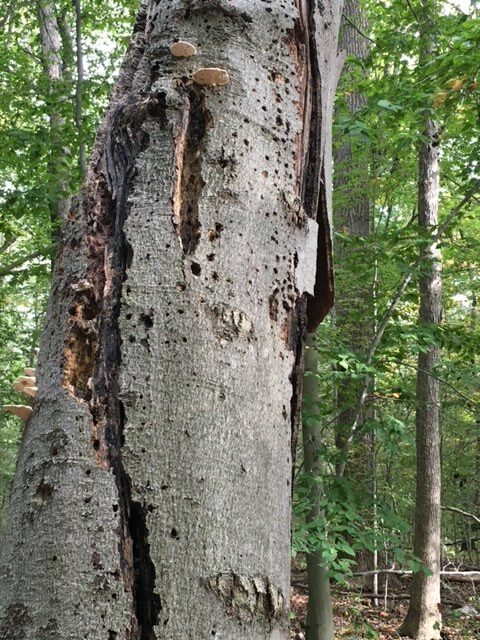
A venerable old snag at the Browne Preserve
A visit to our open space preserves will reveal a number of dead, dying, or fallen trees. Deadwood is a natural phenomenon of forests as they age, or are subjected to disease, lightning strikes, and storm damage. If you wonder why NCLT leaves these dead trees standing or logs where they fall, it is because they are so valuable for wildlife. They also enrich the soil as they decompose and continue to sequester carbon to help offset the effects of climate change.
According to the National Wildlife Federation, dead trees provide vital habitat for more than 1,000 species of wildlife nationwide. Snags (dead or dying trees left upright) provide food, shelter, nesting, and perching sites. Fallen logs are also an important food source. Removal of dead material from a forest can cause considerable loss of habitat.
Here is a look at how snags and logs enhance our wildlife preserves.



Samples of woodpecker holes at Silvermine Fowler, Colhoun, and Browne Preserves
Natural occurring hollows and holes drilled by pileated and other woodpeckers provide ideal nesting spots for themselves and other cavity-nesting birds such as bluebirds, tree swallows, chickadees, titmice, and nuthatches. Larger holes accommodate screech owls, barred owls, and wood ducks who nest in the leftover woodchips (they don’t bring in their own nesting materials). Raccoons, red, gray, and flying squirrels also nest, shelter, and cache food in large tree holes.


Raccoons and flying squirrels nest in tree hollows


Rehabilitated barred owl released by Wildlife in Crisis at Kelley Uplands where numerous swags are available for sheltering and nesting
A perfect spot for an acorn cache at Watson Symington
Tree cavities also provide shelter at night, during storms, and especially in winter. Some songbirds, such as nuthatches, titmice, and chickadees, roost in tree cavities during cold and inclement weather. Spaces under loose bark harbor wrens and brown creepers, as well as, mourning cloak butterflies, the only butterfly that winters as an adult in Connecticut.
Dead and dying wood attracts insects, fungi, mosses, and lichens, contributing to the natural food web. As they work to decompose organic matter and release the nutrients back into the environment, they become food themselves for birds and animals. Many insects overwinter in the outer and inner layers of tree bark, as well as, in the heartwood. Nuthatches, brown creepers, and downy and hairy woodpeckers forage in the outer bark for ants, spiders, and bark beetles. Larger woodpeckers, raccoons, and black bears probe the inner layers for insect larvae and pupae. Pileated woodpeckers drill into the heart food, looking for carpenter ants and termites. Animals with sharp claws, such as bears and raccoons, often peel away, or slough, loose bark to get to the insects beneath.
Fallen Logs are sometimes referred to as “nurse logs.” As they are beset by insects, mushrooms, and other decomposers, they release nitrogen and other nutrients into the soil and sprout new growth.




Fallen logs at Colhoun and Watson Symington support new life
Snags make ideal perches from where hawks and owls can survey the land below for potential prey
Dead and fallen trees are crucial in keeping our ecosystems healthy and vibrant. Unfortunately, landowners often view dead wood and decaying logs as eye sores. If they are located within a wooded area and pose no danger to people or property, why not let them be? They enrich the habitats we live in and augment the natural life that surrounds us.
Recent Comments